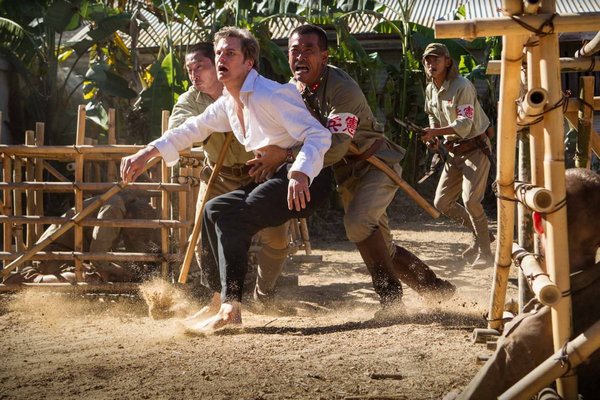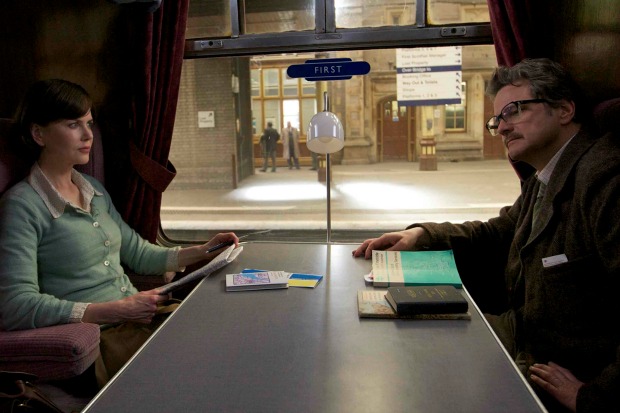The Railway Man | reviews, news & interviews
The Railway Man
The Railway Man
Firth and Kidman star in Eric Lomax's memoir of wartime torture's lingering scars

The agony of war and of surviving it almost destroyed Eric Lomax. A British POW after the fall of Singapore who was put to work by the Japanese on the Burma Railway, he suffered brutal and prolonged torture, trauma he dealt with in subsequent decades by sealing it inside him, and plotting revenge on his abusers as he fell into troubled sleep. Lomax’s memoir The Railway Man describes this and the reconciliation with one of his captors which finally defined his life.
The week after Mandela: Long Walk to Freedom, Jonathan Teplitzky’s film again shows a man’s extraordinary capacity for forgiveness. It also goes further than The Bridge Over the River Kwai, which Lomax thought sanitised, in indicating the relentless savagery which he forgave.
 Casting Colin Firth as Lomax is the film’s great coup. Its producers wanted an actor who doesn’t quite exist anymore, someone like the deeply moving Robert Donat, whose quiet decency, dignity and humour exemplified Britain’s wartime ideal (and which Alec Guinness’s Kwai officer tragically perverted). After The King’s Speech, the more substantial wartime sacrifice of this hero combines Firth’s own instinct for tasteful reserve with his capacity for naked emotion.
Casting Colin Firth as Lomax is the film’s great coup. Its producers wanted an actor who doesn’t quite exist anymore, someone like the deeply moving Robert Donat, whose quiet decency, dignity and humour exemplified Britain’s wartime ideal (and which Alec Guinness’s Kwai officer tragically perverted). After The King’s Speech, the more substantial wartime sacrifice of this hero combines Firth’s own instinct for tasteful reserve with his capacity for naked emotion.
As Canadian nurse Patti Wallace, Nicole Kidman thinks she is meeting a repressed British gentleman in her own Brief Encounter when she starts talking to Lomax on a train in 1980, and they swiftly marry. When Lomax writhes and screams with nightmares on the bedroom floor, and his retreat into himself brutally consumes their marriage, she realises stiff upper lips can snap and scar (a Lomax nightmare of being back in the camp is pictured above).
 The initially charming Firth-Kidman romance (pictured left), and Kidman’s part in the film, are soon subsidiary to an extensive wartime flashback, first teased out of Stellan Skarsgaard’s fellow veteran. Jeremy Irvine matches Firth as the bespectacled, 21-year-old Lomax, a rail enthusiast thrust into horror far from his Scottish home. He rigs a radio to keep spirits up with news of the war’s changing fortunes, as the POWs chip a 250-mile rail line out of towering rock and jungle with picks and spades, in shocking heat and humidity. Over 9,000 British and Australian soldiers died doing so, and over 80,000 local workers. The British Empire also used “native” labour to carve out Asian railways, and the moral murk of a war between competing colonial powers is indicated in a script by Frank Cottrell Boyce and Andy Paterson. But the degree of ruthlessness of the Japanese, and the innocence of Lomax after the radio is discovered and his long torture begins, is unanswerable.
The initially charming Firth-Kidman romance (pictured left), and Kidman’s part in the film, are soon subsidiary to an extensive wartime flashback, first teased out of Stellan Skarsgaard’s fellow veteran. Jeremy Irvine matches Firth as the bespectacled, 21-year-old Lomax, a rail enthusiast thrust into horror far from his Scottish home. He rigs a radio to keep spirits up with news of the war’s changing fortunes, as the POWs chip a 250-mile rail line out of towering rock and jungle with picks and spades, in shocking heat and humidity. Over 9,000 British and Australian soldiers died doing so, and over 80,000 local workers. The British Empire also used “native” labour to carve out Asian railways, and the moral murk of a war between competing colonial powers is indicated in a script by Frank Cottrell Boyce and Andy Paterson. But the degree of ruthlessness of the Japanese, and the innocence of Lomax after the radio is discovered and his long torture begins, is unanswerable.
The Railway Man is uneven in tone and takes great dramatic liberties, creating a climax in which Lomax not only confronts his interrogator Nagase (Hiroyuki Sanada) at the Death Railway tourist site where he works in the film’s present, but cages and means to kill him (unlikely to be encouraged when the BBC filmed the actual meeting in 1993). These heightened dramatic leaps are justified because, like every performance and especially Firth’s, they serve Eric Lomax’s extraordinary story.
The agony of war and of surviving it almost destroyed Eric Lomax. A British POW after the fall of Singapore who was put to work by the Japanese on the Burma Railway, he suffered brutal and prolonged torture, trauma he dealt with in subsequent decades by sealing it inside him, and plotting revenge on his abusers as he fell into troubled sleep. Lomax’s memoir The Railway Man describes this and the reconciliation with one of his captors which finally defined his life.
The week after Mandela: Long Walk to Freedom, Jonathan Teplitzky’s film again shows a man’s extraordinary capacity for forgiveness. It also goes further than The Bridge Over the River Kwai, which Lomax thought sanitised, in indicating the relentless savagery which he forgave.
 Casting Colin Firth as Lomax is the film’s great coup. Its producers wanted an actor who doesn’t quite exist anymore, someone like the deeply moving Robert Donat, whose quiet decency, dignity and humour exemplified Britain’s wartime ideal (and which Alec Guinness’s Kwai officer tragically perverted). After The King’s Speech, the more substantial wartime sacrifice of this hero combines Firth’s own instinct for tasteful reserve with his capacity for naked emotion.
Casting Colin Firth as Lomax is the film’s great coup. Its producers wanted an actor who doesn’t quite exist anymore, someone like the deeply moving Robert Donat, whose quiet decency, dignity and humour exemplified Britain’s wartime ideal (and which Alec Guinness’s Kwai officer tragically perverted). After The King’s Speech, the more substantial wartime sacrifice of this hero combines Firth’s own instinct for tasteful reserve with his capacity for naked emotion.
As Canadian nurse Patti Wallace, Nicole Kidman thinks she is meeting a repressed British gentleman in her own Brief Encounter when she starts talking to Lomax on a train in 1980, and they swiftly marry. When Lomax writhes and screams with nightmares on the bedroom floor, and his retreat into himself brutally consumes their marriage, she realises stiff upper lips can snap and scar (a Lomax nightmare of being back in the camp is pictured above).
 The initially charming Firth-Kidman romance (pictured left), and Kidman’s part in the film, are soon subsidiary to an extensive wartime flashback, first teased out of Stellan Skarsgaard’s fellow veteran. Jeremy Irvine matches Firth as the bespectacled, 21-year-old Lomax, a rail enthusiast thrust into horror far from his Scottish home. He rigs a radio to keep spirits up with news of the war’s changing fortunes, as the POWs chip a 250-mile rail line out of towering rock and jungle with picks and spades, in shocking heat and humidity. Over 9,000 British and Australian soldiers died doing so, and over 80,000 local workers. The British Empire also used “native” labour to carve out Asian railways, and the moral murk of a war between competing colonial powers is indicated in a script by Frank Cottrell Boyce and Andy Paterson. But the degree of ruthlessness of the Japanese, and the innocence of Lomax after the radio is discovered and his long torture begins, is unanswerable.
The initially charming Firth-Kidman romance (pictured left), and Kidman’s part in the film, are soon subsidiary to an extensive wartime flashback, first teased out of Stellan Skarsgaard’s fellow veteran. Jeremy Irvine matches Firth as the bespectacled, 21-year-old Lomax, a rail enthusiast thrust into horror far from his Scottish home. He rigs a radio to keep spirits up with news of the war’s changing fortunes, as the POWs chip a 250-mile rail line out of towering rock and jungle with picks and spades, in shocking heat and humidity. Over 9,000 British and Australian soldiers died doing so, and over 80,000 local workers. The British Empire also used “native” labour to carve out Asian railways, and the moral murk of a war between competing colonial powers is indicated in a script by Frank Cottrell Boyce and Andy Paterson. But the degree of ruthlessness of the Japanese, and the innocence of Lomax after the radio is discovered and his long torture begins, is unanswerable.
The Railway Man is uneven in tone and takes great dramatic liberties, creating a climax in which Lomax not only confronts his interrogator Nagase (Hiroyuki Sanada) at the Death Railway tourist site where he works in the film’s present, but cages and means to kill him (unlikely to be encouraged when the BBC filmed the actual meeting in 1993). These heightened dramatic leaps are justified because, like every performance and especially Firth’s, they serve Eric Lomax’s extraordinary story.
rating
Explore topics
Share this article
The future of Arts Journalism
You can stop theartsdesk.com closing!
We urgently need financing to survive. Our fundraising drive has thus far raised £49,000 but we need to reach £100,000 or we will be forced to close. Please contribute here: https://gofund.me/c3f6033d
And if you can forward this information to anyone who might assist, we’d be grateful.

Subscribe to theartsdesk.com
Thank you for continuing to read our work on theartsdesk.com. For unlimited access to every article in its entirety, including our archive of more than 15,000 pieces, we're asking for £5 per month or £40 per year. We feel it's a very good deal, and hope you do too.
To take a subscription now simply click here.
And if you're looking for that extra gift for a friend or family member, why not treat them to a theartsdesk.com gift subscription?
more Film
 The Perfect Neighbor, Netflix review - Florida found-footage documentary is a harrowing watch
Sundance winner chronicles a death that should have been prevented
The Perfect Neighbor, Netflix review - Florida found-footage documentary is a harrowing watch
Sundance winner chronicles a death that should have been prevented
 Blu-ray: Le Quai des Brumes
Love twinkles in the gloom of Marcel Carné’s fogbound French poetic realist classic
Blu-ray: Le Quai des Brumes
Love twinkles in the gloom of Marcel Carné’s fogbound French poetic realist classic
 Frankenstein review - the Prometheus of the charnel house
Guillermo del Toro is fitfully inspired, but often lost in long-held ambitions
Frankenstein review - the Prometheus of the charnel house
Guillermo del Toro is fitfully inspired, but often lost in long-held ambitions
 London Film Festival 2025 - a Korean masterclass in black comedy and a Camus classic effectively realised
New films from Park Chan-wook, Gianfranco Rosi, François Ozon, Ildikó Enyedi and more
London Film Festival 2025 - a Korean masterclass in black comedy and a Camus classic effectively realised
New films from Park Chan-wook, Gianfranco Rosi, François Ozon, Ildikó Enyedi and more
 After the Hunt review - muddled #MeToo provocation
Julia Roberts excels despite misfiring drama
After the Hunt review - muddled #MeToo provocation
Julia Roberts excels despite misfiring drama
 Ballad of a Small Player review - Colin Farrell's all in as a gambler down on his luck
Conclave director Edward Berger swaps the Vatican for Asia's sin city
Ballad of a Small Player review - Colin Farrell's all in as a gambler down on his luck
Conclave director Edward Berger swaps the Vatican for Asia's sin city
 London Film Festival 2025 - Bradley Cooper channels John Bishop, the Boss goes to Nebraska, and a French pandemic
... not to mention Kristen Stewart's directing debut and a punchy prison drama
London Film Festival 2025 - Bradley Cooper channels John Bishop, the Boss goes to Nebraska, and a French pandemic
... not to mention Kristen Stewart's directing debut and a punchy prison drama
 London Film Festival 2025 - from paranoia in Brazil and Iran, to light relief in New York and Tuscany
'Jay Kelly' disappoints, 'It Was Just an Accident' doesn't
London Film Festival 2025 - from paranoia in Brazil and Iran, to light relief in New York and Tuscany
'Jay Kelly' disappoints, 'It Was Just an Accident' doesn't
 Iron Ladies review - working-class heroines of the Miners' Strike
Documentary salutes the staunch women who fought Thatcher's pit closures
Iron Ladies review - working-class heroines of the Miners' Strike
Documentary salutes the staunch women who fought Thatcher's pit closures
 Blu-ray: The Man in the White Suit
Ealing Studios' prescient black comedy, as sharp as ever
Blu-ray: The Man in the White Suit
Ealing Studios' prescient black comedy, as sharp as ever
 The Woman in Cabin 10 review - Scandi noir meets Agatha Christie on a superyacht
Reason goes overboard on a seagoing mystery thriller
The Woman in Cabin 10 review - Scandi noir meets Agatha Christie on a superyacht
Reason goes overboard on a seagoing mystery thriller
 London Film Festival 2025 - crime, punishment, pop stars and shrinks
Daniel Craig investigates, Jodie Foster speaks French and Colin Farrell has a gambling habit
London Film Festival 2025 - crime, punishment, pop stars and shrinks
Daniel Craig investigates, Jodie Foster speaks French and Colin Farrell has a gambling habit

Add comment